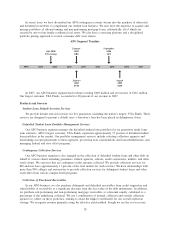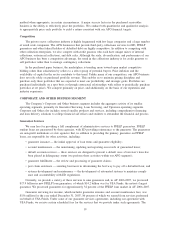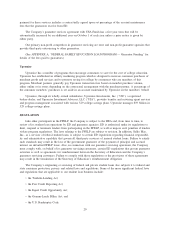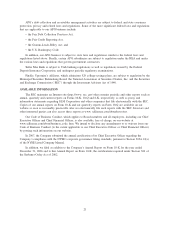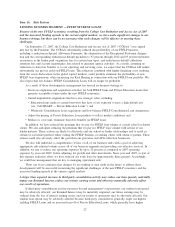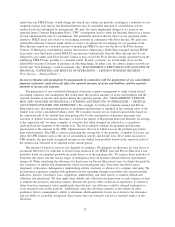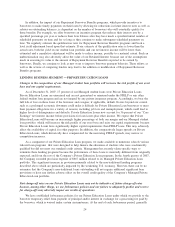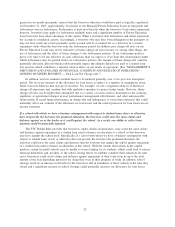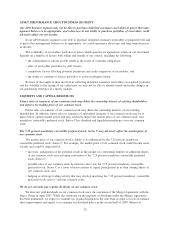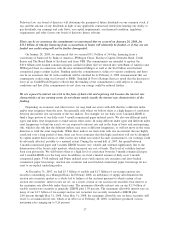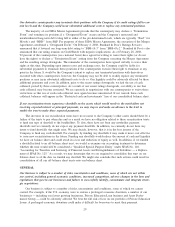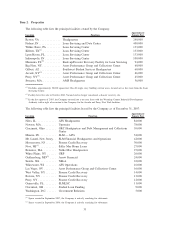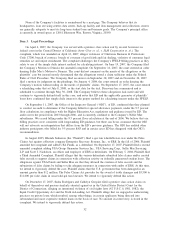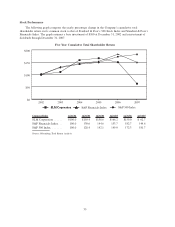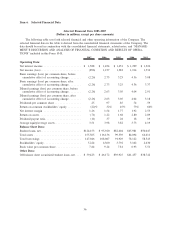Sallie Mae 2007 Annual Report Download - page 29
Download and view the complete annual report
Please find page 29 of the 2007 Sallie Mae annual report below. You can navigate through the pages in the report by either clicking on the pages listed below, or by using the keyword search tool below to find specific information within the annual report.In the past, we employed reset rate note structures in conjunction with the issuance of certain tranches of
our term asset-backed securities. Reset rate notes are subject to periodic remarketing, at which time the
interest rates on the reset rate notes are reset. In the event a reset rate note cannot be remarketed on its
remarketing date, the interest rate generally steps up to and remains LIBOR plus 0.75 percent, until such time
as the bonds are successfully remarketed. The Company also has the option to repurchase the reset rate note
upon a failed remarketing and hold it as an investment until such time it can be remarketed. The Company’s
repurchase of a reset rate note requires additional funding, the availability and pricing of which may be less
favorable to the Company than it was at the time the reset rate note was originally issued. As of December 31,
2007, on a Managed Basis, the Company had $2.6 billion, $2.1 billion and $2.5 billion of reset rate notes due
to be remarketed in 2008, 2009 and 2010, and an additional $8.5 billion to be remarketed thereafter.
We may face limited availability of financing, variation in our funding costs and uncertainty in our securiti-
zation financing.
In general, the amount, type and cost of our funding, including securitization and unsecured financing
from the capital markets and borrowings from financial institutions, have a direct impact on our operating
expenses and financial results and can limit our ability to grow our assets.
A number of factors could make such securitization and unsecured financing more difficult, more expensive
or unavailable on any terms both domestically and internationally (where funding transactions may be on terms
more or less favorable than in the United States), including, but not limited to, financial results and losses,
changes within our organization, specific events that have an adverse impact on our reputation, changes in the
activities of our business partners, disruptions in the capital markets, specific events that have an adverse impact
on the financial services industry, counterparty availability, changes affecting our assets, our corporate and
regulatory structure, interest rate fluctuations, ratings agencies’ actions, general economic conditions and the
legal, regulatory, accounting and tax environments governing our funding transactions. In addition, our ability to
raise funds is strongly affected by the general state of the U.S. and world economies, and may become
increasingly difficult due to economic and other factors. Finally, we compete for funding with other industry
participants, some of which are publicly traded. Competition from these institutions may increase our cost of
funds.
We are dependent on term asset-backed securities market for the long-term financing of student loans. We
expect securitizations to provide approximately 90 percent or more of our funding needs in 2008. If the term
asset-backed securities market were to experience a prolonged disruption, if our asset quality were to
deteriorate or if our debt ratings were to be downgraded, we may be unable to securitize our student loans or
to do so on favorable pricing and terms. If we were unable to continue to securitize our student loans at
current pricing levels or on favorable terms, we would need to use alternative funding sources to fund new
student loan originations and meet our other liquidity needs. If we were unable to find cost-effective and stable
funding alternatives, our funding capabilities and liquidity would be negatively impacted and our cost of funds
could increase, adversely affecting our results of operations and ability to originate student loans.
In addition, the occurrence of certain events such as consolidations and reconsolidations may cause
certain of our securitization transactions to amortize earlier than scheduled, which could accelerate the need
for additional funding to the extent that we effected the refinancing.
The rating agencies could downgrade the ratings on our senior unsecured debt, which could increase our
cost of funds.
Securitizations are the primary source of our long-term financing and liquidity. Our ability to access the
securitization market and the ratings on our asset-backed securities are not directly or fully dependent upon
the Company’s general corporate credit ratings. The Company also utilizes senior unsecured long-term and
short-term debt, which is dependent upon rating agency scoring. As of February 28, 2008, our senior
unsecured long-term debt was rated Baa1, BBB⫺, and BBB and senior unsecured short-term debt was rated
P-2, A-3 and F-3 by Moody’s Investors Service, Inc., Standard and Poor’s Ratings Services, a division of The
McGraw-Hill Companies, Inc., and Fitch Ratings, respectively, and all three rating agencies ratings were under
review for possible downgrade. If any or all of these ratings were downgraded for any reason, our overall cost
of issuing senior unsecured debt could increase.
28


